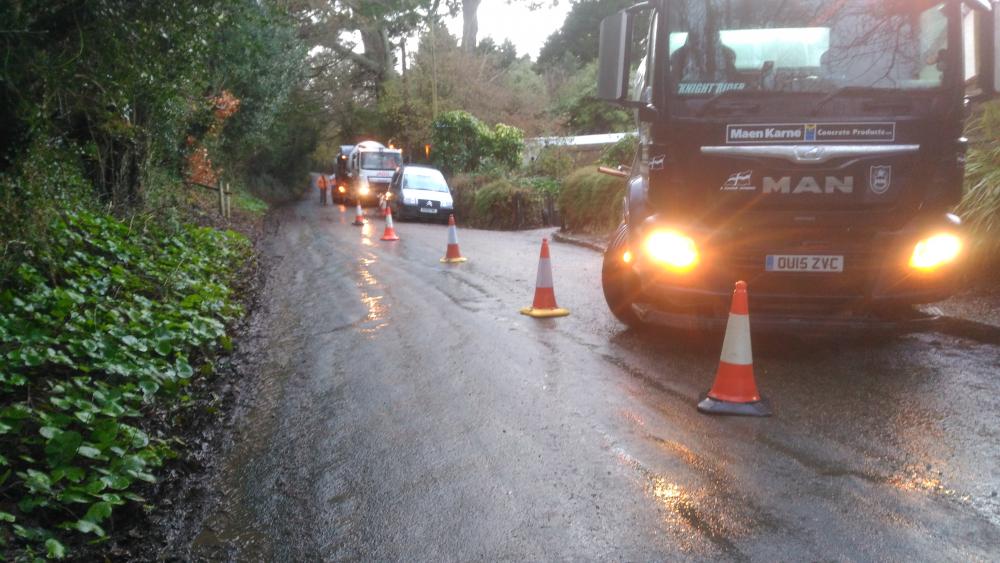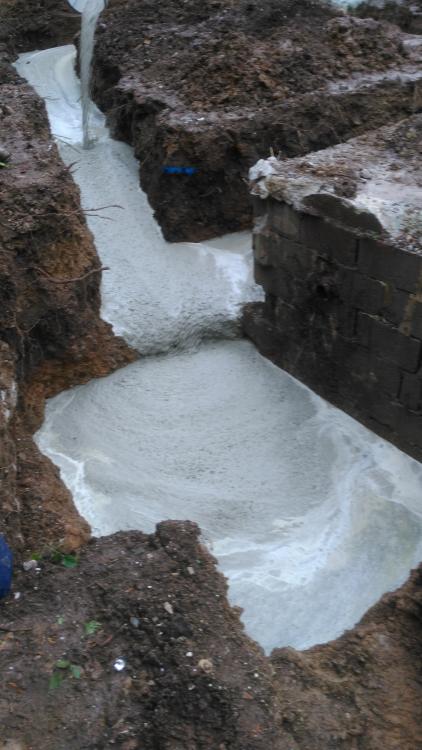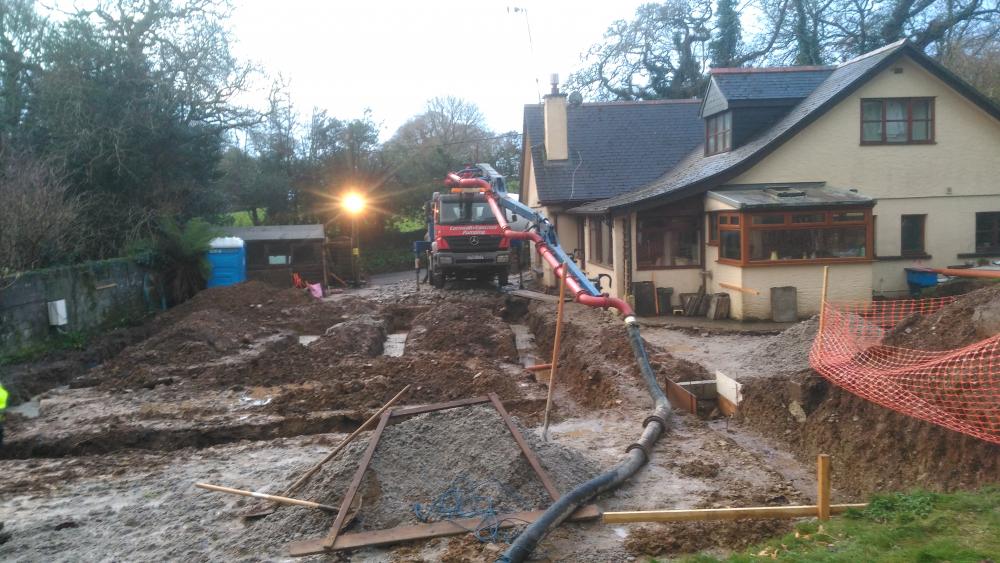Leaderboard
Popular Content
Showing content with the highest reputation on 12/27/17 in all areas
-
6 points
-
Worked: making a plan of what to complete in 2017 Didn't work: fulfilling said plan......5 points
-
Things that worked Getting into the foul drain by having external soil pipes. I knew our levels were going to be very tight, but until we made the final connection, we were unsure how tight. We had measured the invert level of the drain we had to connect to (which was about 12m from the house) and concluded that internal SVPs were not going to work without a pumping station somehwere. So we introduced external Soil pipes on either side of the house, which would not be visible from the front. In the end, we had about 10mm to spare. This saved us in the region of £3k, as well as avoiding the pain of having to do regular pump maintenance. Always use gravity if you can! The MVHR. With easijoists, it is very easy to install an MVHR system and I think all the benefits far outweigh the costs. No bathroom fans to deal with or trickle vents that lose heat. A managed passive ventilation system that virtually no maintenance is an essential. But you do need good levels of airtightness. Underfloor heating. Although we haven't moved in yet, we've had the heating on a tickover setting and it's clear it is going to be fantastic - consistent, controllable, uniform heat throughout the house Things that we'd do differently Watch out for messy bricklayers. Our brickies were incredibly messy, leaving piles of broken bricks and mortar all over the place. It took me the best part of a day to hack off the snots from the scaffold poles. This would have been so much easier if we had put down down groundsheets and taped the ends of the poles. Try to get subbies to hire in the plant they needed, rather than paying for it yourself. We didn't have a main contractor and ended up paying £1600 of VAT that can't be recovered on plant hire. This goes for scaffolding too. Keep it simple. We used a Jetfloor beam and insulated block floor. It was fairly cost-effective but I'm not sure it has many benefits over a traditional beam and block with 300mm insulation construction. Also think about when your underfloor heating and screed will be installed. Use SIPs for the roof, especially if like us you have rooms in the roof. A traditional raftered roof is time consuming to make airtight and well insulated. I think SIPs could offer a much more simple solution. Make sure to think whether you need any holes pre-cut in your steels. We have one large RSJ running across our living room. As soon as it went in, I thought how are we going to get the MVHR ducts through that! I considered using a magdrill to cut a couple of holes (no room) and even taking it out to cut them (very time consuming and difficult). In the end we went over the top into boxed in areas, but it would have been so much better to have thought about it before, or use a castellated beam. Understand that good subbies will be busy. They'll always have a lot of work on. Hanging onto them means being patient and expecting they'll screw up any notion of planning and coordinating trades that are inter-dependent.3 points
-
It is the bit at an end of a project to put the errors right and show extra data.2 points
-
Didn't work: 1. Complicated heating controls, after many months of playing with weather compensation, controlling the house temperature using the floor slab temperature and assuming that the logical link between floor temperature and house temperature would work well at controlling the latter using the former, I realised that, as the heating system only provides a small part of the total house heating, it would never work, so I gave up and installed a very simple room thermostat, which works very well. Should have done this in the first place. 2. Water filled thermal store. No matter how much extra insulation I added around it, the heat losses from it were still very high, over 2 kWh per day (as supplied, with a double layer of insulation, the losses were over 3 kWh/day). This cause the services room to get up to around 40 deg C in summer, damaged the oak door between it and the bedroom and caused the adjacent bedroom to badly over heat. Swapping the thermal store for a Sunamp PV, with it's massively lower heat losses, completely fixed the problem, and freed up lots of room in the services area, too. 3. Complicated ozone injection and flow rate control system on the borehole feed. It worked, but was far too complex and has now been replaced with a much easier to service, very simple eductor, that is far more effective at adding and mixing ozone to the incoming supply and also easier to service and repair. The brass eductor took two goes to get right, but has no parts to wear out, no flexible seals and should last forever. Did work: 1. Choosing an insulation system with a high decrement delay factor. Not only does it significantly improve the comfort level in the house, by helping to keep the internal temperature steady, but it has the added bonus of being an extremely good acoustic insulating material too, so improves the soundproofing and deadens the internal acoustics a fair bit (handy in a house with a lot of hard surfaces). 2. Opting to have UFH inside the insulated concrete slab. This forms a nice big "storage heater", yet responds pretty quickly when needed. Having a heated (or cooled) power floated slab that was flat and smooth enough to lay flooring to directly saved a lot of hassle and money. 3. Choosing the more expensive Genvex MVHR with the internal air-to-air heat pump. It's not massively effective, but does do a pretty good job at keeping the bedrooms a degree or two cooler than downstairs in very hot weather. It also does a great job of drying out towels or washing left on the drying rack in the utility room. 4. Avoiding the use of highly paid consultants etc whenever possible. I found that, with a bit of effort, I didn't need to use many at all. It seems that when you are self-building a house every Tom, Dick and Harry comes at you with their hand held out for more of your hard-earned cash - you can avoid paying out a lot of this with a bit of determination and time.2 points
-
1 point
-
Wherever I buy from I intend having it fitted by the lads doing the rest of the work. ... Unless I fall out with them before that. I#ve seen some work of theirs and it's excellent1 point
-
It is horses for courses - @Mr Punter is correct (and very funny) just a load of chipboard boxes lashed to the wall, and in lashing they probably bugger up your air tightness. Anyway the clear fact is, as he also hints, that its about the doors (painted MDF, book matched obscure veneers or solid gold), the worktop (Melamine, Quartz, Wood, Corrian or whatever), the appliances (double dishwashers, double ovens, Range cookers, AGA, Fridge, Freezer, coffee maker(s) and built in juicer - don't forget to the get brand right, if you cannot afford Gaggeanu - and if you have to ask the price you can't afford it, we won't think the worse of you) and above all the 'usability' of it all so you can entertain your friends while simultaneously producing a gourmet meal that would, had you bothered to enter, have put you at the top of the Master Chef league. All you need to remember is that when you are buying a kitchen you are buying a workplace that has to double as a badge of wealth while exuding your interpretation of effortless style and you had better hope your friends agree otherwise social death, or worse, them sniggering to each other as the leave - 'did you see that kitchen I bet it came straight from ....'! Curiously the super rich don't bother with kitchens because they never go there - only the hired hands do that, and for them IKEA is good enough!1 point
-
I've used Magnet for Larder, Utility and Kennel and am happy with quality and price. Really good Service and delivery, including correcting a couple of errors. Had issues with Howdens in the passed with loads missing from the delivery and then taking many trips back to get it corrected, so wasn't going to do that again. A Trade account gives discounts equivalent to their "70% off Sale", and the sales assistants can then generally do a little bit more, if pushed, by throwing a few bits in for free. We ordered via a Magnet Trade store rather than via a retail store.1 point
-
1 point
-
... who I now believe are the UKs most complained about kitchen company !! I think @Nickfromwales refuses to go near them, as do a lot of people !1 point
-
What a late Christmas present, came through today!!!!!............. Wokingham Borough Council, in pursuance of its powers under the above Acts and Regulations, hereby Grants Permission for the above development to be carried out in accordance with the application and the accompanying plans submitted to the Council subject to compliance with the following conditions, the reasons for which are specified hereunder. Many thanks for all your help and advice, I was a bundle of nerves when i hit this site but everyone of your replies really helped. Thanks again, have a good new years eve and like the great Arnie, i'll be back...soom1 point
-
Thanks for the welcomes and really helpful replies everyone. Very helpful summary Mike and JSH I am interested in tha sunamp concept being married up with a PV system. The fog is lifting.1 point
-
Ah,it's a modified version of English bond,with the stretchers staggered to avoid a weakness with sectional joints as you would have with true bond & header course every 3rd. This bond may have a name but it's not one we were taught for Advanced Craft City & Guild's!1 point
-
Can't quite see from the angle of the photo but from your description sounds like English bond. All long face of block showing one course,all narrow face showing the next? Back to the OP-looks good so far-sectional joints through the wall tell me they know what they're doing (or at very least they know the rules of bonding!)1 point
-
I've got the first iteration of my House system up. It's really too modest to call a Home automation system, as the whole concept is a bit of an anathema to Jan. If I try to have a conversation about any of this with Jan, then her eyes start drooping and her chin dropping in under a minute -- far more effective than sleeping pills or hypnosis. What she wants is a big nob on the wall. (Anyone heard that before?) By way of context my overall approach currently is to use SBCs as headless servers to do the serious processing. These have no realtime I/O functions as this is handed off to dedicated ESP modules to handle the IoT stuff (in my case, though you could just as easily use Atmel/Arduino, RPi0 or equivalent off-the-shelf modules for this). All of my IoT devices are isolate from the House Enet and internet. There is no routing path between. They are on a dedicated private IoT Wifi service which is not advertised and has a nasty password that even I can't remember. There is however a Node Red /broker SBC connected to both networks and its HTTP based UI is access path to the IoT devices. I don't use TLS on the IoT Wifi, as I am not concerned about eavesdropping, however any sensitive data elements are encrypted and all packets digitally signed to prevent injection. But the main thing that I'd like to discuss here is the SBC side. To be honest I am a little dissatisfied with the RPis in this role. I currently split the work between 2 RPis, but since this is a 95:5% split, having the second RPi just complicates things. It is a lot easier just using one server to host Node Red, the MQTT broker and a database. Node Red is an amazing package, but this is really the subject of another topic. But can be a resource hungry if you are not careful, and if I want to store all historic data then I need a decent database and HDD / SDRAM capability. The problem here isn't so much the speed of the RPi CPU, but its limited RAM and the USB2 constraint. I already use a headless configuration on the SBCs using a stripped down Jessie server configuration, but I need a reasonable amount of RAM to run a MySQL InnoDB engine and the node.js pool. And it world also be nice if HDD/SDD performance wasn't USB2 limited. Having reviewed the options, I am going to try a ROCK64 4GB single-board computer which costs £57 including shipping as compared to the RPi at £35, but the Rock64 has 4× the RAM, a USB3 port and it benchmarks at roughly 10× the speed of an RPi3. The CPU speed isn't so much of an issue in this case, but the RAM and USB3 just gives me so much more headroom. It can also boot off eMMC which is faster and more reliable than microSD (though I'll probably just stick with microSD as the root partition will be on the HDD anyway). This Rock64 does have a few downsides: the support and community isn't nearly so strong as for the RPis, but for a basic headless server, it should be fine. There's no on-board Wifi, but there is a second Gb Enet port brought out to the second on-board header so I can just directly connect it to both my main house hub and my IoT Wifi hub. Anyway I'll keep you posted if anyone is interested. Some background context, which can be skipped if you aren't interested I use Wemos ESP8266 modules for all of my I/Os and sensors. These are cheap (<£2 each) so I buy them in lots of 10. This £2 module includes USB power/serial port, Wifi, an embedded flash-based file system and a decent amount of I/O. This is for a few of reasons: I am one of the core developers one of the runtime systems (Lua) for this device as a hobby, so for me it makes sense to use it. When you are breadboarding I/O stuff it is quite easy to fry a GPIO buffer or other board component. At £2 when you've got a dozen spare, this is a shrug; toss the chip and reach for another. RPis cost ~£40 so I don't hold may spares and crisping £40 makes me cringe. Sonoff also do a range of devices, plugs and switches which use the ESP8266 internally so I can buy these and reflash the firmware with my own build. All ESPs are served by a provisioning system, so I can update their Lua applications code as needed (hands free; the chips have embedded Wifi). I currently use 2 RPI3s: one to act as a Node Red / MQTT broker. This has a USB attached HDD. one to control the two ESPs which drive all of my CH and DHW sensors, flow meters, relays, etc. This is second is battery backed. My maintenance policy is centred around keeping a full spares inventory of any modules and SBCs so I can do a quick cold-swap on failure. Overall, I am happy with this approach. It is low cost and very flexible. The ESP mother boards (my equivalent of custom PiHats) are current Beta revs, and I have some changes planned. For example I use two ESPs for my DHW/CH control, but I have decided to consolidate all I/O onto a single ESP as one can handle this comfortably. I also implement a set of safety rules at the ESP tier that are independent of the Node Red Flows; for example: The Willis heater won't turn on if the pump isn't running; it is automatically turned off if any slab return is > 30°C or the Willis chamber itself is >35°C.1 point
-
WORKED using a very good local builder with an excellent reputation DIDNT WORK cant think of anything ( yet)1 point
-
CPC have a massive range of this stuff, modular and assembled. this one doesn't have a phone sockethttp://cpc.farnell.com/global-communications/mswp/global-multi-service-wall-plate/dp/SE00284 and if you splash for a Loftbox or similar then all the multiplexing and sharing is done in one go. http://cpc.farnell.com/global-communications/loftbox-8-g/tvlink-8way-loftbox-psu/dp/SE00366?ost=loftbox&iscrfnonsku=false&ddkey=http%3Aen-CPC%2FCPC_United_Kingdom%2Fsearch1 point
-
Didn't work - appendix worked - having it removed! 17 been crap in health and business but few irons in the fire already for next year and feeling good.1 point
-
Worked - Sheet metal decking for garage roof. Engineer had selected 3 mahoosive beams to span 7m (garage width) with three separate sections of block n beam spanning between them (in 3m5m sections) , to be topped with a structural topping. Very expensive and labour intensive. Opted for sheet metal decking which spanned the 7m, tek screwed together and hit fixed to the walls. Rebar in the troughs, A252 mesh on top and a 270mm slab. Really straight forward to install, roof in a day, rebar in a day, propping half a day, pour concrete half a day. Didn't work - taping and filling. I had a go in the kitchen and whilst to the casual observer it looks fine,if you shine a light certain ways, it's crap. At least I had a go, but glad I got the rest of the house skimmed. Wisdom on here recommended against tnf but I had to have a go. Best left to experts!1 point
-
1 point












